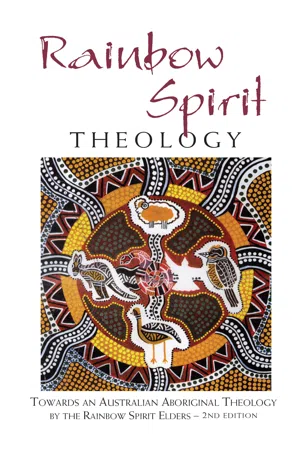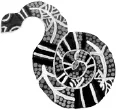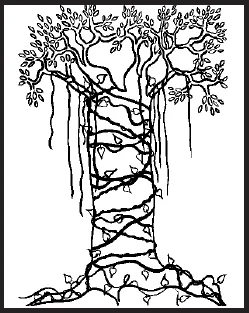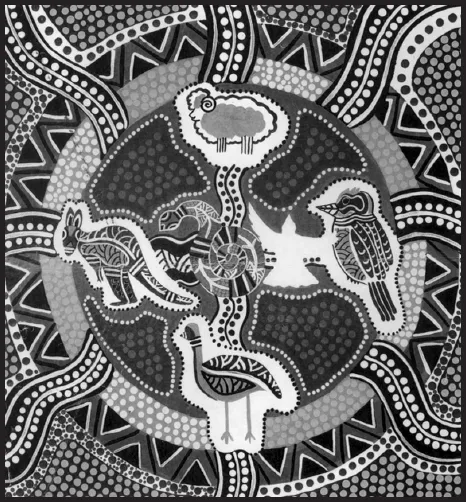![]()
chapter one
THE NECESSITY OF RAINBOW SPIRIT THEOLOGY
High on the branch of a kauri pine in a Queensland rainforest, a small bird rests. Having previously fed on the sweet fruit of the Ficus, the bird excretes seeds and leaves them in a small, wet patch of manure on the branch, then flies away.
Several weeks later, in the humid conditions, one fertilised seed has sprouted many leaves. Long, hair-like roots have begun to snake downwards, seeking soil and moisture. The seed has come back to the land to grow and develop. Having reached the humus-rich floor of the rainforest, the parasitic fig draws aloft life-giving nutrients.
In the months that follow, the young tree flourishes. High in the canopy, a trunk and branches are formed. Meanwhile, the thin hair-like roots begin to embrace its host and thicken.
In time, the roots of the fig swell so much that the generous host is slowly crushed. The parasitic plant is commonly known as the strangler fig.
Late last century, missionaries came to Aboriginal groups in North Queensland. These well-meaning men and women themselves suffered dangers, hardship and isolation. In time, they established permanent settlements, medical clinics, farms and churches.
Being convinced of the vital importance of the Christian message, they sought to convert our people to their Christian beliefs and habits. Some tried to understand the customs of our people. One or two tried to understand our religion. For the most part, our religious beliefs and ceremonies were regarded as pagan, barbaric and evil. The sooner these were replaced with civilised Christianity, the better for all concerned; or so they thought!
Because most missionaries had little regard for the beliefs and practices which were central to the way of life of our people, and actively promoted a European culture as superior, our people became confused. During the workshop, one of the participants remembered how ‘white German missionaries brought us a white German Jesus... Now I can finally see that Jesus Christ is like me. He has my skin, my colour — everything like me. Now I know Christ camped among us, built his humpy among ours’.
Many of our people were humiliated by punishments handed out by the foreigners. The rule of the missionaries was supported by the power of the government — and its police force. Our elders had a sacred responsibility as the caretakers of this land and its resources. Because they could no longer exercise this care, they lost their purpose in life. The core beliefs of our people were rejected. The self-esteem of our people was destroyed. And the spirit of our people was crushed.
Many Aboriginal people today affirm the positive message of the Gospel brought by the missionaries, but see the rejection of our traditional culture as unnecessary and destructive. The Christian message was imposed from above and, like the strangler fig in the story, gradually choked the life out of our rich spiritual tradition — and therefore out of our people themselves. How much better it would have been for our people if that message had been planted in Australian soil, and encouraged to take on its own form and find its own place in its new cultural environment.
Now that many dozens of Christian Aboriginal people have undertaken formal theological education, we have begun to evaluate the theology and history of the missions in the light of our own reading of the Scriptures and our own experience as Christian Aboriginal people. This book represents one such evaluation.
To help our people face the future with confidence, we need to examine closely what remains of our traditional spirituality in the light of the Christian Gospel. We have begun to construct our own Christian theology to strengthen our people for the future and to offer new directions for Australia. This book represents one step in that direction. It represents a new expression of pride in our culture and in our faith.
As one participant at the workshop confessed:
Jesus was thrust down my throat. I was not encouraged to think for myself or allow a theology to grow from within me as an Aboriginal. I had to get rid of the ‘dependency baggage’. I was told what to do, what to think, where to live. I was not free. I now need to think things through, to feel my own needs, work through my own faith, and develop my own Aboriginal theology.
This task is not an exercise in intellectual game-playing. It is literally a matter of life and death. Behind the tragedy of many Aboriginal communities (poor health, high infant mortality, low life-expectancy, high unemployment, poor housing, alcoholism, malnutrition, deaths in custody — the list goes on) lies a deep spiritual crisis. Because of the approach of many missionaries and the attitude of non-Indigenous Australians in general, many of our people feel a deep sense of shame, a lack of worth and a feeling of being lost.
Our people have been entrusted by the Creator Spirit with the care of the land and the associated ceremonies. In most parts of Australia, they are unable to care for their land and ensure its continued fruitfulness because it has been taken over by the immigrants. The ceremo-nies have lost much of their meaning for most Aboriginal people. The spiritual line of succession, from the time of creation through countless generations, has now been broken. And deep inside, our people live with guilt and hopelessness.
In spite of the massacres, the poisonings, the epidemics, the tearing apart of families and all the other horrendous sufferings of our people, we have survived.
Our task now is to mould a new spirituality that will bring healing to our people, that will create a sense of pride and identity in our youth and strengthen them to take their rightful place both in this nation and in the world community. This book affirms our past spirituality as the work of the Creator Spirit and provides a basis for a bold Indigenous faith.
This book is important for a second reason. In some churches, the old Christian colonialism continues. Pastors and priests continue to impose on our people a European expression of the Christian message as though this were the only valid expression of the truth. Most of our Aboriginal pastors have been indoctrinated into this European Christianity. And the very things which crushed the spirit of our people in the past continue to do so today.
Many of our people suffer silently inside, but they are too polite or confused to declare their suffering openly.
Because we respect our European and Western Christian leaders, we want to help them come to a fresh understanding of Christianity which is faithful to the Scriptures — and is also genuine Good News for all people. It is our hope that these Christian leaders will be able to see the damage they are doing and free them selves from the European cultural bondage in which their theology is imprisoned.
Thirdly, we believe that Rainbow Spirit Theology has something to offer the whole of Australia. In our country, too, economic values often take precedence over human and spiritual values. Genuine cooperation — in which all parties are respected and everyone wins — is replaced by confrontation and competition. The whole sale destruction of our land continues. In the sixty or more thousand years that our people have been in this continent, we have learned to live in this land. We want to share it with all Australians in a way that will ensure a better future for all our children.
The Spirit of God is speaking to and through Aboriginal Australians. God does not speak to us first and foremost through European and Western theology. God accepts us as we are. Our people need to be free of the terrible burden of believing that they need to think and live like Europeans before they can be Christians. We need to chop down the strangler figs which are choking us so that we can be free to be what God wants us to be. We need to hear the Gospel expressed in our own language and culture. Only then will the spirits of our people be free. Then we will all, Aboriginal and immigrant, join in the joyous laughter of the kookaburra, and we will all, Aboriginal and immigrant, recognise the rainbow as a symbol of our spiritual unity in Christ.
One of the workshop participants summarised our task in these words:
The Jewish people struggled to lift the temple veil that shrouded God as revealed to us in Jesus Christ. We are in the process of lifting the veil of God’s revelation in our culture. We are lifting the veil to see God, to see Christ in ourselves and our culture. In so doing, we are connecting with peoples in every culture. For Aboriginal people, Christ was behind a curtain. Some were able to see Christ through a small gap in that curtain. We now need the courage to push our heads through the curtain so that we really can see God in Christ, in our own culture, in our own world, where we are.
We also recognise that during the history of the Christian church in Australia, there have been missionaries and other church people who, in spite of government policies and the paternalistic attitude of most churches, have supported Aboriginal people. Some supporters helped us keep our land, some opposed oppressive policies and some intervened, risking their lives to save Aboriginal people from being killed. In more recent times, some supporters have genuinely helped us in our struggle for justice and the preservation of our culture. Sad to say, these supporters in the church have been all too few.
The Sources of our Rainbow Spirit Theology
![]()
chapter two
DOING RAINBOW SPIRIT THEOLOGY
1. Doing Rainbow Spirit Theology is not new. In recent years, Christian Aboriginal people have been reflecting openly about the links between Christian teachings and their Aboriginal culture.
When the European missionaries first arrived, we Aboriginal people found it difficult to accept the claim of many missionaries that all or most of our Aboriginal culture was wrong. In more recent times, Christian Aboriginal people have come to realise that much of what we learned from the Scriptures, especially the Old Testament, is similar to what we knew from our own culture.
Christian Aboriginal thinkers have reflected on these similarities and made many connections between our own Aboriginal culture and our Christian faith. This reflection, whether written or oral, is a living and developing indigenous Aboriginal theology.
We have called the indigenous theology developed by our group ‘Rainbow Spirit Theology’. This theology endorses the writings of our leaders such as Djiniyini Gondarra, who wrote the following in the introduction to his series of reflections on Aboriginal theology, Let My People Go:
During the past ten years there have been many Christian Aborigines, both men and women, who have gained a deeper understanding about God. In this way they have realised the great contribution our culture can make towards a deeper understanding of the Christian faith in Australia today. (1986, p. iv)
2. Rainbow Spirit Theology assumes that God the Creator Spirit has been speaking through Aboriginal culture from the beginning.
European missionaries were mistaken when they claimed that they had been sent to reveal God to spiritually blind Aboriginal Australians. God, the Creator Spirit, was already here. Our Aboriginal culture was already spiritual, more overtly spiritual than the European culture of those who invaded Australia. God was already speaking to us through the law revealed in the land.
The New Testament Letter to the Hebrews talks of God speaking in many and various ways to our ancestors (Hebrews 1:1). We believe that this text applies equally well to the ancestors of our Aboriginal people as it does to the ancestors of the people of Israel. The Creator Spirit spoke to us in many ways, especially through the land which links us to the Creator Spirit.
As one of our workshop group said:
Aboriginal culture is spiritual. I am spiritual. Inside of me is spirit and land, both given to me by the Creator Spirit. There is a piece of land in me, and it keeps drawing me back like a magnet to the land from which I came. Because the land, too, is spiritual.
This land owns me. The only piece of land I can claim a spiritual connection with — a connection between me and the land — is the piece of land under the tree where I was born, the place where my mother buried my afterbirth and umbilical cord. The spiritual link with that piece of land goes back to the ancestors in the Dreaming. This is both a personal and...




